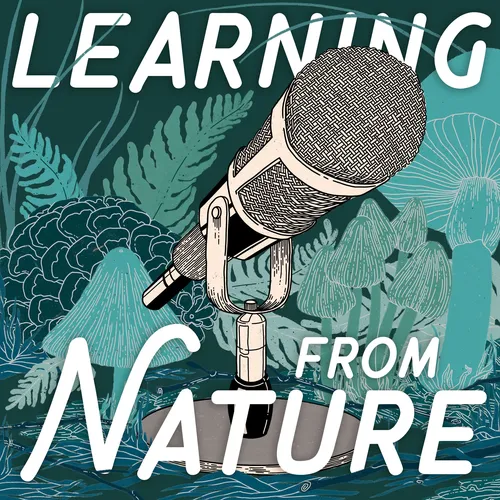
Learning from Nature: The Biomimicry Podcast with Lily Urmann
We share Earth with millions of other species, many of whom have been around much longer than us. Biomimicry is the promising practice of learning from nature’s forms, processes, and systems to create life-friendly designs that benefit both people and the planet. Lily Urmann – a biomimic, educator, and nature communicator – will explore this exciting field and showcase how biomimicry is applied and practiced around the world; from architecture and engineering to material science, manufacturing, business, design and everything in-between. Join Lily as she dives into the brilliant and beautiful world of how nature works and interviews biomimics across cutting-edge disciplines. Together, let’s discover what we can learn from nature!
- Update frequency
- every 32 days
- Average duration
- 44 minutes
- Episodes
- 31
- Years Active
- 2022 - 2025

Biomimicry in Architecture with Michael Pawlyn
What does it look like for humans to align with life? The built environment and urban areas represent a massive opportunity to significantly lower emissions, improve biodiversity, and create healthie…

Biomimicry in Visual Design with Michelle Fehler
Many of us are familiar with applying nature's genius to physical products or the built environment, but we can also integrate this practice into visual design fields and processes. Michelle Fehler, …

What Biomimicry is Calling For with Alistair Daynes
The world is ready for learning from nature to take off, but what does biomimicry really need in order to gain more traction on a larger scale? Listen in to our special live episode with Learn Biomim…

Bio-Alchemy and Diving into Nature’s Sleight of Hand with Andrew Meador
Humans are a very young species. Compared to the other organisms that we share this planet with, we are novices in how to live in harmony here. Mimicking nature’s elegant and efficient structures on …

Special Episode: Nature Journaling with John Muir Laws
Cultivating a curiosity for our world is the first step in repairing our relationship with place, the organisms that we share our planet with, and ourselves. This reconnecting is at the core of a cru…

Behind the Scenes Biomimicry: Inside the Launchpad Program
The Biomimicry Institute's Launchpad program supports scientists and designers who are addressing some of our biggest challenges with nature-inspired ideas. Every year, a cohort of innovators from ar…

Behind the Scenes Biomimicry: Mycocycle is Transforming Waste with Fungi
Humans view waste as a burden, but nature utilizes waste as a valuable resource in a cycle of continual renewal. The US Environmental Protection Agency estimates 600 million tons of construction and …

Behind the Scenes Biomimicry: ECOncrete is Creating Sustainable Marine Ecosystems
Our coastlines are crucial buffer zones for climate chaos. Yet the current building strategies for concrete coastal marine construction can lead to low biodiversity, which impacts ecosystem health an…

Behind the Scenes Biomimicry: GreenPod Labs is Reducing Food Waste
Globally, more than 1.6 billion tonnes of food is wasted every year -- and in India, 40% of produce goes to waste before it even reaches grocery store shelves. By learning from plant protection mecha…

Behind the Scenes Biomimicry: Amphico is Revolutionizing the Textile Market
The ideal adventure apparel is both waterproof and breathable. Yet the tragic irony for outdoor enthusiasts is how toxic and wasteful the current clothing and gear options there are on the market. Th…

How Does Nature Cooperate? All About Lichens with Dr. Troy McMullin
It's on every continent, and in every terrestrial ecosystem. It's beneath our feet on most hikes and it's often overlooked: lichens! In this episode, Dr. Troy McMullin, the chief lichenologist at the…

Knowledge Symbiosis with Roxanne Swentzell and Anne LaForti
In the fourth episode of our limited series Knowledge Symbiosis: Can Biomimicry and Indigenous Science Harmonize?, Roxanne Swentzell and Anne LaForti engage in a conversation hosted by Sara El-Sayed,…

Knowledge Symbiosis with PennElys Droz and Maibritt Pederson
In the third episode of our limited series Knowledge Symbiosis: Can Biomimicry and Indigenous Science Harmonize?, PennElys Droz and Maibritt Pederson Zari engage in conversation hosted by Lily Urman…

Knowledge Symbiosis with Dayna Baumeister and Melissa K Nelson Part 2
In this second episode of the limited series Knowledge Symbiosis: Can Biomimicry and Indigenous Science Harmonize?, Dayna Baumeister and Melissa K Nelson continue their conversation, hosted by Sara E…

Knowledge Symbiosis with Dayna Baumeister and Melissa K Nelson Part 1
In this inaugural episode of the limited series Knowledge Symbiosis: Can Biomimicry and Indigenous Science Harmonize?, Dayna Baumeister joins Melissa K. Nelson and Sara El-Sayed in a conversation exp…

Multi-functionality of Mucus and the Microbiome with Erin Miller
A fun fact for your next party conversation: humans have over 30 trillion cells in our bodies, and 70-90% of those cells are bacterial and fungal! Look no further than exploring the microbiomes of bi…

Green Chemistry: The Beauty of Nature's Processes with Dr. John Warner
Many of us are either afraid of or avoid chemistry simply because of the way we were taught the topic in school. Yet chemistry is all around us: in the leaves of your backyard tree and the snail inch…

Mushroom Magic: How Does Nature Modify Light/Color? With Ximena Curiel
If you've ever sat on the forest floor marveling at a beautiful red or purple mushroom, this episode is for you! My guest and fellow biomimic Ximena Curiel will dive deep into what mushrooms are, why…

How Does Nature Modify Light and Color? With Raphael Kay
Our buildings use A LOT of energy to heat and cool, and because of this they contribute drastically to global carbon emissions. But what if we borrowed design inspiration from the amazing ability of …

How Does Nature Communicate? African Wild Dog Democracy with Ebenezar Wikina
Our world is full of intricate, complex, and elegant strategies. In this episode we explore one such strategy that might surprise you: the decision-making sneezes of African wild dogs. Explore this u…